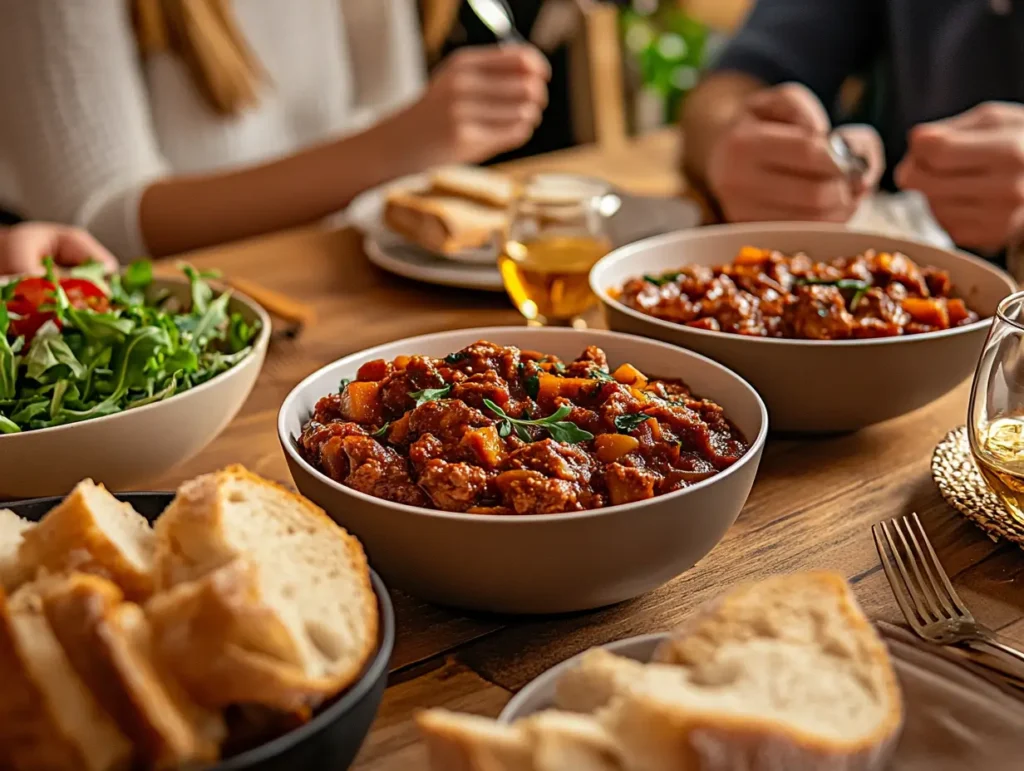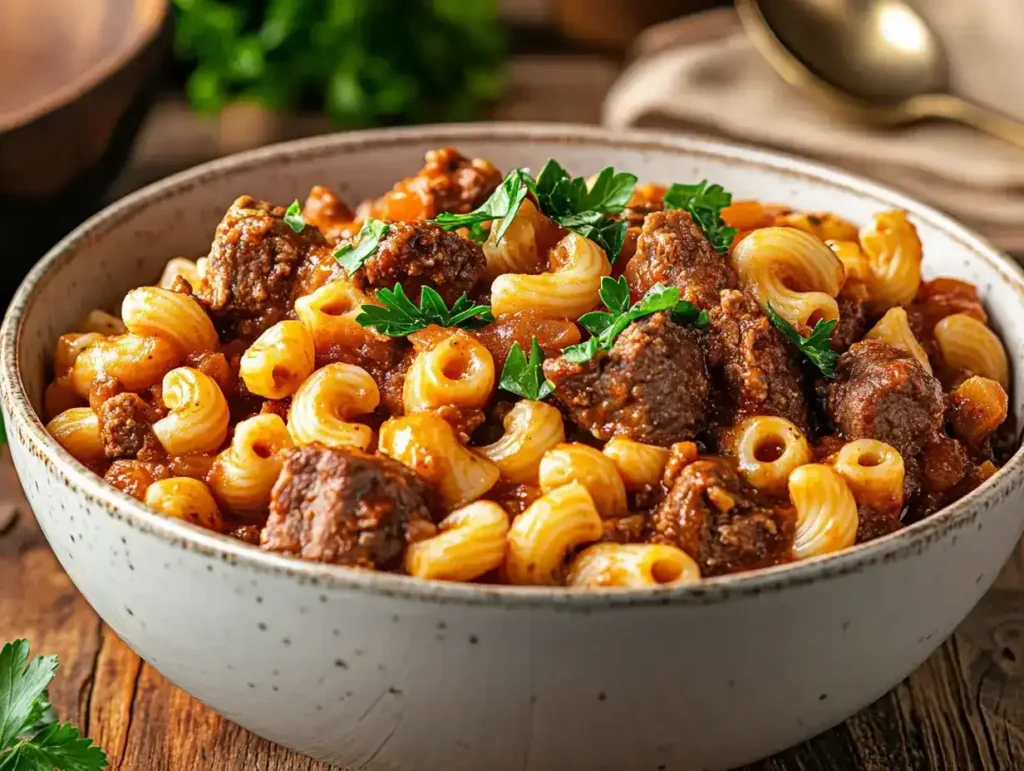A Hearty Dive into Timeless Comfort Food
There’s something magical about a steaming bowl of old-fashioned goulash recipe—a dish that wraps you in warmth like a well-loved blanket. Whether you’re a seasoned cook or a kitchen newbie, this guide is your ticket to mastering a meal that’s equal parts nostalgia and nourishment. We’ll journey through the rich history of Hungarian goulash, unpack the secrets of its authentic ingredients, and walk you through foolproof steps to create this hearty beef stew at home. Along the way, you’ll discover creative twists to suit modern diets, tips for pairing it with crowd-pleasing sides, and even how to keep leftovers tasting fresh. So grab your Dutch oven and a sprinkle of Hungarian paprika—we’re about to turn simple ingredients into a symphony of flavor!
Table of Contents
The History and Origins of Old-Fashioned Goulash
The Roots of Hungarian Goulash
Picture this: 9th-century Hungarian shepherds, huddled around campfires, simmering cauldrons of meat and spices. That’s where our beloved old-fashioned goulash recipe began—not as a fancy feast, but as a humble peasant stew designed to fuel long days. The word “goulash” itself comes from the Hungarian gulyás, meaning “herdsman.” Back then, it was little more than dried beef, onions, and water, thickened with leftover bread. But when Hungarian paprika exploded in popularity during the 18th century, this simple dish transformed into a national icon.
How Old-Fashioned Goulash Became an American Staple
Fast-forward to the 19th century, when Hungarian immigrants brought their paprika-based stew to American shores. Here, it collided with local tastes and pantry staples. Enter elbow macaroni, canned tomatoes, and a dash of Midwestern pragmatism. The result? A hearty, one-pot wonder that fed families during the Great Depression and beyond. Unlike its Hungarian cousin, which leans heavier on broth and spices, the American goulash we know today is thicker, tomato-ier, and often dubbed “slumgullion” (a cheeky term for “cheap meal”). Yet both versions share a soul-warming DNA that’s stood the test of time.
Essential Ingredients for an Authentic Old-Fashioned Goulash Recipe
Core Components of Traditional Goulash
At the heart of every old-fashioned goulash recipe lies a handful of simple yet powerful ingredients. First up, beef—preferably a tougher cut like chuck roast or stew meat, which becomes melt-in-your-mouth tender after slow cooking. Next, onions and garlic form the aromatic base, infusing the dish with depth and sweetness. Then comes the star of the show: Hungarian sweet paprika. This vibrant spice isn’t just for color—it’s the soul of goulash, delivering a smoky, slightly sweet flavor that’s unmistakable.
Tomatoes, whether fresh, canned, or in paste form, add a tangy richness that balances the paprika’s warmth. And let’s not forget the elbow macaroni, a staple in American goulash that soaks up all the savory goodness. Finally, a splash of beef broth or water ties everything together, creating a luscious, hearty stew.
Optional Add-Ins for Flavor Customization
While the basics are non-negotiable, there’s plenty of room to play around. For instance, bell peppers add a pop of color and a subtle sweetness, while caraway seeds lend an earthy, slightly nutty note. If you’re feeling adventurous, a dash of hot paprika or cayenne pepper can kick up the heat.
For those with dietary restrictions, swaps are easy. Use gluten-free pasta or zucchini noodles for a low-carb twist. Ground turkey or plant-based meat can replace beef, though you’ll want to adjust cooking times to avoid dryness. And if you’re out of Hungarian paprika, a mix of smoked and sweet paprika can work in a pinch.
For more tips on ingredient swaps, check out our guide on How to Adapt Recipes for Dietary Restrictions.
Step-by-Step Guide to Cooking Old-Fashioned Goulash

Preparing Your Ingredients Like a Pro
Before you fire up the stove, a little prep goes a long way. Start by chopping your onions and garlic finely—this ensures they melt into the sauce, adding flavor without overwhelming bites. Cut the beef into uniform cubes, about 1-2 inches, so they cook evenly. Measure out your spices, including that all-important Hungarian paprika, and have your tomatoes and broth ready to go.
Pro tip: If you’re using elbow macaroni, cook it separately and add it at the end. This prevents it from soaking up too much liquid and turning mushy.
Cooking Techniques for Perfect Old-Fashioned Goulash
- Brown the Beef: Heat a bit of oil in a large pot or Dutch oven over medium-high heat. Add the beef in batches, letting it sear until it’s browned on all sides. This step locks in flavor and creates a rich base for your stew.
- Sauté the Aromatics: Toss in the onions and garlic, cooking until they’re soft and fragrant. This is where the magic starts—the sweetness of the onions balances the paprika’s smokiness.
- Add the Spices: Sprinkle in the Hungarian paprika, along with any other spices you’re using. Stir well to coat the meat and onions, letting the heat wake up the spices’ flavors.
- Simmer to Perfection: Pour in the tomatoes and broth, scraping up any browned bits from the bottom of the pot. Bring the mixture to a boil, then reduce the heat and let it simmer gently for 1.5 to 2 hours. The low-and-slow approach ensures the beef becomes fork-tender and the flavors meld beautifully.
- Finish with Pasta: If you’re using elbow macaroni, stir it in during the last 10 minutes of cooking. This gives it just enough time to soak up the sauce without losing its texture.
For more one-pot meal ideas, explore our collection of Easy One-Pot Dinners.
Variations of Old-Fashioned Goulash to Try
Regional Twists on Classic Goulash
While the old-fashioned goulash recipe holds a special place in many hearts, it’s fascinating to see how different regions have put their own spin on it. In Hungary, for example, goulash is more of a soup, with a thinner broth and chunks of potatoes instead of pasta. Over in Germany, you’ll find goulashsuppe, a spicier version often served with dumplings. And let’s not forget Austria, where goulash is typically paired with spätzle, a soft egg noodle that soaks up the rich sauce beautifully.
In the U.S., the Midwest has made goulash its own, turning it into a hearty, tomato-based casserole with elbow macaroni. Some versions even include cheese, giving it a gooey, comforting twist. Whether you stick to tradition or venture into new territory, each variation offers a unique take on this timeless dish.
Modern Dietary Adaptations
These days, goulash isn’t just for meat lovers. Vegetarians can swap beef for hearty mushrooms or lentils, while keto fans might skip the pasta altogether and opt for cauliflower rice. If you’re short on time, an Instant Pot or slow cooker can work wonders, cutting down cooking time without sacrificing flavor.
For a lighter version, try using ground turkey or chicken instead of beef. And if you’re gluten-free, simply replace the elbow macaroni with your favorite gluten-free pasta. The beauty of goulash lies in its adaptability—it’s a dish that welcomes creativity.
For more creative twists on classic recipes, check out our article on Chicken Butternut Squash Soup
Serving and Pairing Your Old-Fashioned Goulash

Traditional Side Dishes to Complement Goulash
A bowl of old-fashioned goulash is a meal in itself, but the right sides can take it to the next level. Crusty bread is a must—it’s perfect for sopping up every last bit of sauce. For a refreshing contrast, serve it with a side of pickled vegetables, like cucumbers or red onions. A dollop of sour cream or a sprinkle of fresh parsley adds a cool, creamy finish that balances the dish’s richness.
Creative Presentation Ideas for Family Dinners
Want to impress your guests? Try serving goulash in bread bowls for a fun, rustic touch. Or, layer it in a casserole dish, top with shredded cheese, and bake until bubbly for a crowd-pleasing twist. For a lighter option, garnish with fresh herbs like dill or chives, and serve alongside a crisp green salad.
No matter how you serve it, goulash is a dish that brings people together. It’s hearty, comforting, and endlessly customizable—perfect for weeknight dinners or special occasions.
Storing and Reheating Old-Fashioned Goulash
Best Practices for Refrigeration and Freezing
Let’s face it—goulash often tastes even better the next day, once the flavors have had time to meld. To store your old-fashioned goulash recipe, let it cool completely before transferring it to an airtight container. In the fridge, it’ll stay fresh for up to 4 days. If you’re planning to freeze it, portion it into meal-sized containers or freezer bags. Properly stored, goulash can last in the freezer for up to 3 months. Just remember to leave a little space at the top of the container, as the liquid will expand as it freezes.
How to Reheat Goulash Without Losing Flavor
When it’s time to enjoy your leftovers, reheating is a breeze. For the stovetop, simply warm it over medium heat, stirring occasionally to prevent sticking. If you’re in a hurry, the microwave works too—just cover the dish and heat in short bursts, stirring in between. For larger portions, the oven is your best bet. Place the goulash in an oven-safe dish, cover with foil, and bake at 350°F until heated through. Add a splash of broth or water if the sauce seems too thick.
FAQs About Old-Fashioned Goulash Recipe
Can I use ground turkey instead of beef in old-fashioned goulash?
Absolutely! Ground turkey is a leaner option that works well in goulash. Just keep an eye on the cooking time, as it can dry out faster than beef.
What’s a substitute for Hungarian paprika in goulash?
If you don’t have Hungarian paprika, a mix of smoked paprika and sweet paprika can do the trick. It won’t be exactly the same, but it’ll still add depth and warmth to your dish.
How do I prevent my goulash from becoming too watery?
To avoid a soupy goulash, simmer it uncovered toward the end of cooking. This helps reduce the liquid and thicken the sauce. Alternatively, you can stir in a cornstarch slurry (1 tablespoon cornstarch mixed with 2 tablespoons water) to achieve the desired consistency.
Is old-fashioned goulash freezer-friendly?
Yes, it freezes beautifully! Just make sure to store it in airtight containers or freezer bags, and it’ll keep for up to 3 months. Thaw it in the fridge overnight before reheating.
Tips and Tricks for Perfecting Your Old-Fashioned Goulash Recipe
Choosing the Right Cut of Beef
When it comes to making a stellar old-fashioned goulash recipe, the cut of beef matters. Opt for tougher cuts like chuck roast or stew meat, as they become tender and flavorful when slow-cooked. Avoid lean cuts, which can dry out and lose their texture. Pro tip: Trim excess fat before cooking to keep the dish from becoming too greasy.
Balancing Flavors Like a Pro
Goulash is all about harmony. Start by caramelizing your onions—this adds a natural sweetness that balances the smokiness of the paprika. If your dish tastes too acidic from the tomatoes, a pinch of sugar can mellow it out. On the other hand, if it’s too sweet, a splash of vinegar or lemon juice can brighten it up. Don’t forget to taste as you go and adjust the seasoning accordingly.
Avoiding Common Mistakes
One of the biggest pitfalls is overcooking the pasta. To prevent mushy noodles, cook them separately and add them at the end. Another mistake? Skimping on the paprika. Hungarian paprika is the backbone of this dish, so don’t be shy with it. Lastly, give your goulash time to simmer—rushing the process can result in underdeveloped flavors.
Why Old-Fashioned Goulash Recipe is a Timeless Classic
A Dish That Brings People Together
There’s a reason the old-fashioned goulash recipe has stood the test of time—it’s more than just food; it’s comfort in a bowl. Whether it’s a family dinner or a potluck with friends, goulash has a way of bringing people together. Its hearty, satisfying nature makes it a crowd-pleaser, while its simplicity ensures it’s accessible to cooks of all skill levels.
Adaptable to Any Occasion
From weeknight dinners to holiday feasts, goulash fits seamlessly into any meal plan. It’s easy to scale up for large gatherings or pare down for a cozy night in. Plus, its versatility means you can tweak it to suit your tastes or dietary needs. Whether you stick to tradition or experiment with modern twists, goulash remains a dish that feels both familiar and exciting.
A Legacy of Flavor
At its core, goulash is a celebration of humble ingredients transformed into something extraordinary. It’s a reminder that great food doesn’t have to be complicated—it just has to be made with care. So the next time you whip up a batch of old-fashioned goulash, take a moment to appreciate the rich history and timeless appeal of this beloved dish.
Conclusion: Savor the Timeless Comfort of Homemade Goulash
There’s no denying it—old-fashioned goulash recipe is more than just a meal. It’s a warm hug on a chilly evening, a nostalgic nod to simpler times, and a dish that bridges generations. Whether you’re whipping it up for a busy weeknight dinner or serving it at a family gathering, this hearty stew has a way of making everyone feel at home.
From its humble roots in Hungarian pastures to its modern-day twists in American kitchens, goulash has proven its staying power. With simple ingredients, bold flavors, and endless adaptability, it’s a recipe that invites creativity while staying true to its soul-warming core.
So grab your Dutch oven, dust off that paprika jar, and dive into the joy of cooking this classic dish. After all, food isn’t just about filling bellies—it’s about creating memories. And with every bite of your homemade goulash, you’re adding a delicious chapter to your own story.
Related Recipes:

